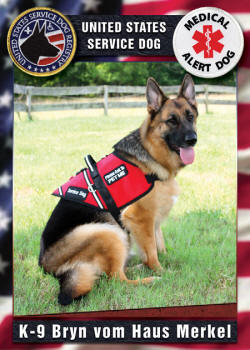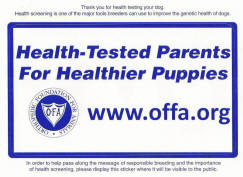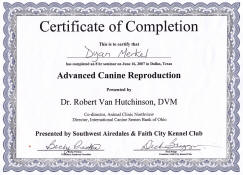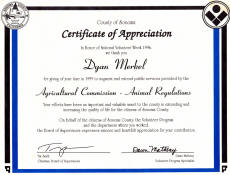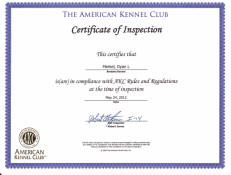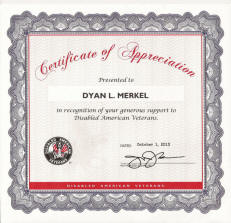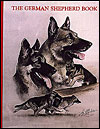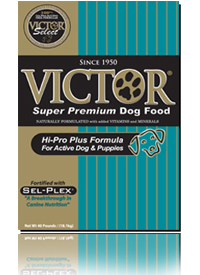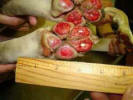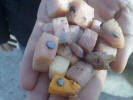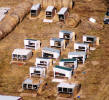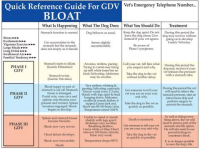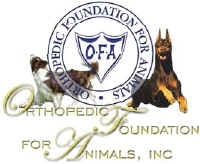|
"IT'S ALL IN THE TIMING" - FRESH-CHILLED VERSUS FROZEN
ARTIFICIAL INSEMINATION IN THE BITCH
Jane Barber DVM, MS, DACT
Introduction
Great advances in canine assisted reproduction techniques
have been achieved during the past 20 years. In additional
to natural breeding, artificial inseminations with fresh
"neat" (unextended) semen, fresh-chilled extended semen and
frozen semen are now viable
breeding options. With each technological advance, so too
come more manipulations by human hands and an increased risk
for human error in semen processing and insemination.
When good quality, fresh semen is used for breeding with
either natural mating or "side by side" artificial
inseminations, there is much forgiveness with respect to
breeding timing. This is because fresh semen remains highly
viable and "fertilizable" for 5 to 6 days once deposited in
utero.
Live spermatozoa have been recovered from the uterus up to
11 days post-breeding. In contrast, survival of fresh,
"neat" semen in extrauterine environments is poor.
Advances in preserving extrauterine longevity of
spermatozoa include both reducing energy consumption and
increasing energy sources by and for the sperm cells.
Lowering the temperature of sperm cells slows metabolism and
reduces their energy consumption. Replacing seminal plasma
with extender bathes sperm cells in an energy-rich
environment.
However, even optimally extended and cooled spermatozoa fail
to survive nearly as long as their fresh, intrauterine
counterparts. Fresh-chilled sperm cells have a relatively
short life span. Fresh-chilled semen, once warmed to body
temperature and in utero, lives about 24 to 72 hours.
Properly frozen sperm cells can be stored indefinitely in
liquid nitrogen at -322°F (-180°C). Once thawed, however,
sperm cells have an ultra-short life span. Frozen-thawed
spermatozoa live an average of 12 hours, 24 hours maximum!
Curtailed sperm cell longevity necessitates precise
ovulation timing and breeding.
Ovulation Timing
Ovulation timing (OVT) is an art as well as a science.
Unlike other species in which ovulation occurs in an
estrogen environment, ovulation in the canine occurs only
after progesterone levels have risen to >4ng/ml. Another
unique feature is that the bitch ovulates ova in the primary
oocyte stage. These primary oocytes must undergo another
meiotic division and further maturation before they can be
fertilized. Unlike most species in which
breeding/insemination is timed to coincide with ovulation,
insemination in the bitch is performed 2 to 4 days after
ovulation.
It is important to remember that, in the
bitch, the critical timing events occur 4 to 6 days before
the optimal breeding dates.
A number of tools are available for ovulation timing.
These include LH (luteinizing hormone) assays, qualitative
and quantitative progesterone assays, vaginal epithelial
cytology, vaginoscopy, examination of external genetalia and
behavioral assessment. Success in breeding is
optimized when as many tools as possible are utilized to
time ovulation. While ovulation timing constitutes an entire
discussion of its own, a brief description of each tool
follows.
Estrogen
Estrogen levels rise, peak and begin to decline during
proestrus. Under the influence of estrogen, the vulva and
vagina become edematous, a serosanguinous vulvar discharge
(of uterine origin) is present, the vaginal epithelium
becomes thickened and cornified and the bitch exhibits
behavioral signs of estrus. However, blood estrogen levels
are highly variable, do not accurately predict ovulation and
are not useful as a tool for timing ovulvation.
LH (Luteinizing Hormone)
Hypophyseal LH is the biological trigger for the cascade of
events that culminate in ovulation. Following a variable
period (1 to 21 days) of estrogen level elevation, the LH
surge signals the transition from proestrus to estrus. LH
stimulates follicular granulosa cells to secrete
progesterone. The LH surge is the key timing event dictating
days of
peak fertility. Ovulation begins 2 days post-LH surge and
continues for another day or so. Ova mature and are capable
of fertilization 2 days later. Mature ova live another 1-3
days. Optimal breeding times are day 4, 5, and 6 post-LH
surge. Pinpointing the day of the LH surge is
cumbersome. The LH surge is short-lived, typically lasting
only 12 to 24 hours. Therefore, daily blood testing is
required. LH is a species specific hormone and assays
are not currently available from commercial laboratories in
the US. A qualitative (test kit) assay is available for
in-hospital use, but it has a short shelf life (3 months
maximum). LH assays are most often used in the timing for
breedings with frozen semen.
Progesterone
Progesterone's initial rise occurs concomitantly with the LH
surge. At that time, baseline progesterone levels
(<1.5ng/ml) rise to 1.5-2.0 ng/ml. After the initial rise,
progesterone continues to rise and may reach levels of 10-15
ng/ml by the end of the fertile period. Ovulation occurs
when progesterone levels are between 4 and 10 ng/ml.
Plan breedings 4 to 6 days after the initial rise,
and 2 to 4 days after the onset of ovulation. Since
baseline and initial rise levels can vary from individual to
individual, it is important to start testing early enough to
define the baseline progesterone level. The gold standard
for determining progesterone levels is quantitative
measurement by radioimmunoassay. Results are reported in ng/ml.
Progesterone, like all steroid hormones, is not
species-specific and can be measured commercially by human
and veterinary laboratories alike. Several semiquantitative
ELISA progesterone kits are available, Status-Pro [Synbiotics],
Target [Biometallics], and PreMate [Camelot Farms], for
example. Results are intrepreted from a color change in the
test well or membrane. Hemolyzed blood samples will falsely
lower the result. If test kit components are not warmed to
room temperature, then a falsely high result will be
interpreted. The general consensus is that test kits are
usually adequate for most natural breedings, but are not
accurate enough when planning a fresh chilled or frozen
breeding. Recommendations for progesterone testing
include starting to test around day 5 or 6 from onset
of sign of proestrus, followed by testing every other day
until ovulation has been confirmed. However, some females
have very short seasons and require testing at the
first sign of proestrus. Others may not ovulate until after
21 or more days. When in
doubt, start testing early.
Evaluation of External Genetalia
During proestrus, the vulva is swollen and a sersanguinous
vulvar diacharge (of uterine origin) is present. As
proestrus transitions to estrus, vulvar edema diminishes and
the vulvar discharge becomes straw colored. Note however,
that some normal bitches may have a hemorrhagic discharge
that persists throughout estrus. With the onset of diestrus,
vulvar edema subsides completely.
Behavior
The proestrous bitch attracts males but will not stand to be
mounted. During estrus, the bitch will stand, "flag" and
allow the dog the mount. With the onset of diestrus,
the bitch will refuse to stand and be mounted.
Exfoliative Vaginal Cytology
During early proestrus, estrogen concentrations are low, and
cytology specimens show parabasal and intermediate cells,
red blood cells, neutrophils and bacteria. As proestrus
progresses, estrogen levels rises and the vaginal epithelium
thickens. The number of superficial cells increases and the
number of red blood cells gradually decreases. By the
end of proestrus, more than 80% of the epithelial cells are
cornified red blood cells. During estrus, vaginal smears
contain >90% cornified superficial epithelial cells, red
blood cells are few in number and neutrophils are absent.
With the onset of diestrus, vaginal cytology abruptly
changes from that seen during estrus to one showing few
superficial cells, a predominance of parabasal and
intermediate cells and many neutrophils. Practically,
vaginal cytology samples are useful for identifying
inflammation in the reproductive tract. If a large number of
neutrophils are seen on an estrus smear, then a vaginal
culture and sensitivity may be indicated. Cytology is also
useful for differentiating proestrus, estrus and diestrus.
It is not useful for determining ovulation
date within the estrous period.
Vaginoscopy
Vaginoscopy is a useful tool for estimating the LH surge and
optimally fertile period. During proestrus, the
vaginal mucosa becomes edematous and has a billowing pillow
appearance on vaginoscopy. Around the time of the LH surge,
vaginal edema decreases
and the vaginal folds become wrinkled or crenulated. Maximal
crenulation occurs during the optimal fertile period several
days later. As diestrus approaches, the vaginal mucosa
takes on a blotchy white and pink appearance.
Tips for Success With Fresh Chilled Semen
Planning the Breeding
1. Don't commit to organizing and performing a breeding if
you cannot be available on weekends and holidays.
2. Plan the breeding with young, healthy fertile
individuals. Since this is almost always out of the
clinician's control, special measures may need to be taken
if either the bitch or dog is aged or known to be subfertile.
For example,
fresh chilled semen of marginal quality may necessitate
surgical rather than vaginal insemination to achieve
pregnancy.
3.
Recommend that the bitch owner always have a Plan B ready to
be implemented in the event that the scheduled breeding
encounters a "hitch".
4. Start ovulation timing early, particularly in females who
have not had their cycles "tracked" before.
5. If the dog has never been collected and shipped before, a
trial collection and "chill check" is advisable at least a
week before to the anticipated shipping date. This ensures
that he can be collected and that his semen quality is
maintained with addition of buffer and chilling.
Semen Collection, Processing and Packaging
1. Schedule collections to minimize the collection to
insemination time interval. Shipment usually involves
an overnight FedEx service.
2. Use an estrous teaser bitch whenever possible.
Spermatozoa number and quality are maximized when a teaser
bitch is available. As much as a four-fold increase in
spermatozoa number can be realized when using a teaser
bitch. General guidelines for adequate semen quality include
>70% motility, >70% morphologically normal spermatozoa, few
inflammatory cells, and a normal sperm count. Sperm count
should approximate 10 million spermatozoa per pound of body
weight.
7. If collected sperm numbers are marginal (<250 million
sperm), wait 45 minutes and collect the dog a second time.
If the total number of sperm cells remains low, recommend
that the dog owner allow you to call the bitch owner to
confirm that he or she still wants to have the suboptimal
collection shipped.
8. When collecting the dog, collect only the sperm-rich
second fraction of the ejaculate. Excess prostatic fluid is
deleterious to semen quality. If excess prostatic fluid is
present, centrifuge the ejaculate, decant off the
supernatant and resuspend the sperm pellet in an appropriate
extender. Follow semen processing directions carefully. Many
extenders are available, each with its own handling
instructions.
9. When extending semen, it is important to know how the
insemination will be performed. Surgical insemination
requires much less total volume than does vaginal
insemination. For routine vaginal insemination, the total
volume should be appropriate for the size of the bitch.
Generally, 2 to 3 mls is adequate for small breeds, 4 mls
for medium breeds, 6 mls for large breeds and up to 10 mls
for giant breeds.
10. Send the extended semen sample in a conical shaped
centrifuge tube with a screw cap. Make sure the tube does
not leak. It is also a good idea to wrap the cap with a
layer of parafilm. Placing the tube inside a whirl pack or
sealable plastic bag allows for recovery of semen should a
leak occur.
11. A number is shipping containers are available
commercially, including Equitainers and Camelot Farms
shippers. Styrofoam boxes also work adequately in most
instances. In Europe, insulated Thermos-type containers are
popular. The bagged tube is placed in the box along
with 1 or 2 frozen gel pack or Kool-It brick. The tube
should not be placed in direct contact with the frozen
coolant. Make sure that the tube is separated from the
brick by at least 4 to 6 layers of paper towel or newspaper.
The tube can be wrapped with an insulating material
or the tube can be placed in a smaller Styrofoam box. More
newspaper (sufficient to fill the dead space) is packed
between the brick and the tube. Alternatively, one
refrigerated brick can be placed between the frozen brick
and the tube, still using newspaper to fill dead space.
12. Most fresh chilled semen is shipped via FedEx. UPS can
also be used. It is important to make sure that the package
can be shipped overnight with an AM delivery the next day.
When dealing with weekend inseminations, make sure that
package can be delivered on Saturday mornings. There are
often special boxes on the shipping form that need to be
checked for AM and Saturday delivery.
13. Prior to the 9/11 terrorist attack, counter to counter
shipment of semen offered a convenient option when weekend
inseminations were placed. With a counter to counter
shipment, the dog owner typically picked up the package from
the collecting veterinarian's office and took it to the
nearest airport where it was put on a flight to the airport
designated by the bitch owner. Delta Dash and US Air both
offer reliable services. The bitch owner would pick up the
package from the airport and take it to the inseminating
veterinarian's hospital. Since 9/11, counter to counter
shipments are problematic because the sender must be a
"known shipper" to be granted shipping privileges by
airlines.
14. The collecting veterinarian should call and give the
inseminating veterinarian the FedEx or UPS tracking number
of the shipment.
15. The cost of semen collection and shipping is typically
the bitch owner's responsibility. It is helpful to get the
bitch owner's credit card information so that services and
FedEx fees can be billed directly to them.
Semen Delivery, Handling and Insemination
1. On the day of scheduled semen collection, call the
collecting veterinarian's office and obtain the tracking
number for the shipment.
2. When fresh chilled semen package arrives, it should be
opened immediately. Attention should be paid to the
"impression of coldness." The ice packs should be at least
cold, if not still frozen.
3. The tube containing the semen should be removed from the
packaging material (usually newsprint). The tube should
contain the extended semen in a liquid state. Unfortunately,
occasional mishandling by the shipping company or by the
shipper placing the semen package in a non-pressurized
compartment of the airplane will cause the sample to arrive
frozen. The freezing kills the sperm cells and renders
the sample useless.
4. One drop of the sample should be placed on a warmed
microscope slide. The rest of the sample should be
refrigerated. Allowing the chilled sample to warm to room
temperature only allows the sperm cells to speed up, using
precious energy and shortening their life span.
5. Semen arriving looking "DOA" may still be viable. Some
extenders render the sample immotile and additional of an
activator buffer is required to restore sperm cell motility.
Warming or transferring apparently lifeless semen into fresh
extender may bring it back to life. Perform test
manipulations on only a drop of semen. As the semen drop
warms, side to side motility becomes noted. The continued
warming eventually shows the cells to have achieved a normal
forward progression. As the drop warms on the slide, the
accompanying paperwork with the semen collector's evaluation
of the semen quality. Time of collection and post collection
motility should be studied. The semen drop is then analyzed
and compared to the collector's evaluation.
6. If no motility is noted after 15 minutes, the sample is
most likely non-viable. If this occurs, the collector of the
semen should be contacted to determine, if possible, the
cause of the semen's demise. In other cases where only
partial semen recovery is noted, the inseminator must use
judgment based on the concentration of the semen, estimated
total spermatozoa numbers and the percent recovered. It may
also be necessary to alter the insemination method to that
of an intra-uterine deposition of the fresh chilled sperm to
further reduce sperm cell stress and to aid its arrival at
the fallopian tubes.
7. The refrigerated fresh chilled sample need not be warmed
to room temperature or body temperature before insemination.
Having the sample in the uterus as it warms makes maximum
use of the conserved energy. All fresh chilled semen samples
are handled in a similar manner, however, many different
commercial companies sell packaging kits and extenders. One
should always read their instructions for any specific
handling recommendations before using the semen.
8. Most often, fresh chilled semen is inseminated vaginally.
The pregnancy rate for vaginal inseminations using good
quality semen should be at least 80%. Surgical insemination
or TCI (transcervical insemination) can be performed to
increase pregnancy rate. Deposition of the semen directly
into the uterus improves pregnancy rate when chilled semen
quality is marginal. Uterine deposition of semen also
improves pregnancy rate in very small and giant breeds of
dogs, which
are reported to have less success with vaginal
inseminations.
9. To perform a vaginal insemination, the pipette is
introduced through the doral vulvar comissure, directed
dorsocranially through the vagina until it enters the pelvic
vagina. Then the pipette is directed cranially as far as
possible, ideally to the external cervical os. The bitch's
hind end is elevated to a 45 degree angle while the semen is
injected through the pipette. The dorsal vaginal wall is
gently "feathered" for a moment or two while the hind end
remains elevated for 10 minutes. Care is taken not to place
pressure on the caudal abdomen during this
time.
10. Recent reports indicate that elevating the hind end for
longer than one minute offers no advantage over a one minute
elevation.
11. Save the semen tube for DNA verification of paternity
should that become necessary.
Tips for Success With Frozen Semen
Planning the Breeding
1. Again, if you agree to plan and perform an insemination
with frozen semen, you must be available to perform the
insemination should it need to be performed on a weekend or
holiday.
2. Insemination with frozen semen necessitates precise
timing of ovulation. All available tools should be utilized
to pinpoint the period of optimal fertility.
3. In planning a breeding involving international shipment
of semen, care must be taken to ensure that all the
receiving country and kennel club requirements are met. This
often involves several forms, health certificates and blood
tests. The addresses and information for a large number of
Kennel Clubs world-wide can be found on the website (www.fci.be)
of the Fédération Cynologique International.
4. Dog semen is allowed entry into the United States
provided it is accompanied by a certificate endorsed by the
animal health official in the country of origin. The
certificate must certify either that the semen extender does
not contain milk products OR that if milk products
were used, they originated from a country recognized as free
of foot-and-mouth disease by the USDA. Requirements for
semen import into the United States can be obtained from the
United States Drug Administration (USDA) P.O. Box 3220,
Minneapolis, MN 55403-1503, USA, website (www.aphis.usda.gov).
5. The AKC requests a prior application to permit AI by
imported semen. They also request a DNA sample, which can be
ordered via E-mail:dna@akc.org. It is taken with the aid of
a special cheek-swab kit supplied by the AKC. The AKC can
also be reached at5580 Centerview Drive, Raleigh, NC
27606-3390, USA. Phone: 919-233-9767 or 919-854-0124; Fax:
919-233-3627 or 919-854-0102;
website:www.akc.org.
Semen Collection and Freezing
1. Semen is collected in routine fashion.
2. Semen is frozen. There are many methods of freezing, each
with its own set of buffers, cryoprotectants, and freezing
protocol. Some methods are proprietary and require franchise
purchase. Proprietary agencies include Canine Cryobank,
CLONE , International Canine Semen Bank (ICSB), and
Synbiotics. Nonproprietary systems, with published
protocols, include the Norwegian Tris extender, the Uppsala-Equex
extender and its modification, the Uppsala-Equex 2 extender.
3. Semen is frozen in either straw or pellet form. The semen
is usually frozen so that the final number of spermatozoa
per straw or pellet is between 100 and 200 million.
Depending on the semen quality, usually 2-4 straws are used
for each AI. In smaller breeds producing fewer spermatozoa
per ejaculate it may be desirable to freeze a less
concentrated semen to obtain more straws.
4. The semen sender must provide the inseminating
practitioner with adequate information about the quality of
the semen they send and, in the case of frozen semen,
information about how the semen should be thawed, because
the method of thawing is dependent on how the freezing was
done, and the methods vary among freezing facilities.
5. If, however, the semen is of unsatisfactory quality it
should not be shipped unless the bitch owner or importer is
informed about the situation and has given consent.
Semen Shipping and Thawing
1. To ship frozen semen a liquid nitrogen container is
required. The container must maintain the temperature at
around -197°C. Today most semen freezing facilities use
dry-shippers, called dewars.which absorb the liquid nitrogen
into a porous material in their walls. These will not spill
and therefore need not to be shipped as dangerous goods,
which is more expensive. They should, however, always be
sent
as fragile goods, because they are easily broken by rough
handling. The tank is usually shipped in a plastic box for
protection.
2. If the inseminating veterinarian has a liquid nitrogen
storage tank, then the frozen semen can be shipped in a dry
shipper or dewar well in advance of its anticipated date of
use. This relieves the angst associated with overnight
shipments at the last minute. If a storage tank is not
available, most dewars can safely store semen for up to 4 to
5 days.
3. When removing semen from the storage tank, check the
labeling to ensure that the information on the straw or vial
matches that on the accompanying paperwork, and that the
paperwork is as expected (correct name, breed, etc. of dog).
4. Because of the many freezing methods employed today, it
is critically important to follow the accompanying handling
and thawing instructions implicitly.
5. Straws are thawed in a water bath. Common thaw methods
include immersion at 70°C for 8 seconds, 50°C for 10 seconds
or 37°C for 30 - 60 seconds. Thawing is complete when the
bubble rises to the top of the straw. After thawing, any
water
remaining on the outside of the straw is carefully wiped off
before opening the straw. Some methods may direct you to
empty straws into pre-warmed thaw medium.
6. Semen frozen in pellets is stored in vials. When removing
a vial from the storage tank, care must be taken to
carefully loosen the vial cap and let all liquid nitrogen
vaporize prior to removing the cap. Pellets are then quickly
transferred and sealed in a whirl pack bag which is plunged
into a water bath. Pellets are massaged through the bag to
aid in the rapid thaw process.
7. Save the straws or whirl pack bag so that cells are
available for DNA verification should that become necessary.
Insemination of Frozen Semen
1. Normally, frozen semen is inseminated directly into the
uterus. At present, there are three methods for depositing
semen directly into the uterus: surgical insemination, blind
transcervical passage of a rigid catheter into the uterus,
and endoscopic transcervical passage of a catheter into the
uterus.
2. Surgical insemination is performed with the bitch under
general anesthesia. The uterus is exteriorized through a
ventral midline laparotomy approach. The thawed semen,
contained in a sterile syringe, is injected into the uterine
horn at a 45° angle, with a 22 or 23 gauge needle, bevel up.
Half of the volume is injected into each uterine horn. After
the needle is withdrawn, a saline-moistened gauze
sponge is held over the injection site until hemostasis is
achieved.
3. Both Scandinavian and Norwegian rigid catheters are used
for blind transcervical insemination. To perform the
insemination, the outer sheath is passed as far as possible
cranially into the vagina, the internal stainless steal
catheter is advanced into the fornix adjacent to the
external cervical os, the cervix is palpated through the
abdomen, grasped and manipulated onto the end to the
catheter, then the
catheter is advanced through the cervix. This method
requires considerable training, practice and skill.
Anesthesia of the bitch is not required.
4. Endoscopic transcervical insemination is referred to as
the New Zealand method. The equipment needed includes a 5 mm
diameter, 36 cm long rigid endoscope with a 30° viewing
angle, a sheath for the catheter, a light source and an
optional viewing monitor. An 8 French polypropylene urinary
catheter is inserted into the channel on the sheath and the
endoscope/sheath/catheter combination is passed as
a unit into the cranial vagina. The external cervical os is
visualized and passage of the catheter into the cervix can
be confirmed. Anesthesia is not required.
5. With both transcervical techniques, semen should not be
thawed until correct catheter placement is achieved. These
can be lengthy procedures and sometimes catheter passage is
not achieved, thereby necessitating a change in plans to
surgical insemination.
References
Andersen K. Insemination of frozen dog semen based on a new
insemination technique. Zuchthygiene 1975; 10:1-4.
Gotwals S. Canine reproduction seminar. Proc AKC Canine
Health Foundation Seminar, University of Florida, March
2000, 1-33.
Van Hutchison R. Maximizing conception rate. In: Canine
Reproduction for Breeders, The Iams Company, Dayton, OH,
2001; 8-12.
Linde-Forsberg C. Intra-uterine insemination in the dog
using the Scandinavian transcervical catheter and a
comparison with other methods. In: Concannon PWC, England
GCW and Verstegen J eds. Recent Advances in Small Animal
Reproduction. Ithaca:
International Veterinary Information Service( www.ivis.org)
2001; A1207.0201.
Linde-Forsberg C. Fertility data from 2041 controlled
artificial inseminations in the dog.
In: Proc 4th Internat Symp on Canine and Feline Reprod,
Oslo, 2000; 120
Linde-Forsberg C, Ström Holst B and Govette G. Comparison of
fertility data from vaginal vs intrauterine insemination of
frozen thawed dog semen: A retrospective study.
Theriogenology 1999; 52:11-23.
Peña A and Linde-Forsberg C. Effects of spermatozoal
concentration and post-thaw dilution rate on survival after
thawing of dog spermatozoa. Theriogenology 2000;
54(5):703-718.
Peña A and Linde-Forsberg C. Effects of Equex, one- or
two-step dilution, and two freezing and thawing rates on
post-thaw survival of dog spermatozoa. Theriogenology 2000;
(54)6:859-875.
Pinto C, Eilts B and Paccamonti D. The effect of reducing
hindquarter elevation time after artificial insemination in
bitches. Theriogenology 1998; 50, 301.
Rota A, Ström B and Linde-Forsberg C. Effects of seminal
plasma and three extenders on canine semen stored at 4°C.
Theriogenology 1995; 44(6):885-900.
Rota A, Linde-Forsberg C, Vannozzi J, Romagnoli S &
Rodriguez-Martinez H.
Cryosurvival of dog spermatozoa at different glycerol
concentrations andfreezing/thawing rates. Reprod Dom Anim
1998; 33:355-361.
262 Thomassen R, Farstad W, Krogenaes A, Fougner JA and
Andersen Berg K. Artificial insemination with frozen semen
in the dog. A retrospective study. J Reprod Fertil Suppl
2001; 57:341-346. Wilson M. Non-surgical intrauterine
artificial insemination in bitches using frozen semen. J
Reprod Fertil Suppl 1993; 47 (Suppl):307-311.
Wilson M. Transcervical insemination techniques in the
bitch. Vet Clin North Am - Small Anim 2001; 31:291.
This site
designed and maintained by Dyan Merkel of
DLM DESIGN STUDIO
|

